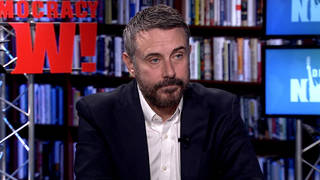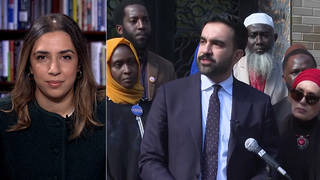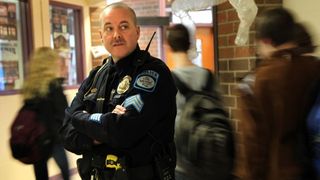
Guests
- Judith Browne Dianisco-director of the Advancement Project. She is a civil rights litigator and racial justice advocate. She helped author a new report titled “A Real Fix: The Gun-Free Way to School Safety.”
- Paul Barrettassistant managing editor at Bloomberg Businessweek and author of Glock: The Rise of America’s Gun.
The National Rifle Association has unveiled the recommendations of its “School Shield” task force, calling for armed guards at every school in the country. We get reaction from Judith Browne Dianis, a civil rights litigator, racial justice advocate and co-director of the Advancement Project. Browne Dianis helped author the new report, “A Real Fix: The Gun-Free Way to School Safety,” part of a week-long series of actions led by students in cities across the country to oppose the deployment of police in schools. “We know that more police means criminalization of young people, especially young people of color and LGBTQ youth,” she says. “The young people they’re there to protect often become the young people who are hauled off in handcuffs.” We’re also joined by Paul Barrett, assistant managing editor at Bloomberg Businessweek and author of “Glock: The Rise of America’s Gun.” [includes rush transcript]
Transcript
AMY GOODMAN: On Tuesday, the National Rifle Association called for armed guards to be placed in every school in the country. That was the conclusion of an NRA task force called “School Shield,” headed by former Republican Representative Asa Hutchinson of Arkansas. The NRA’s press conference at the National Press Club was held under unprecedented security. The NRA had a bomb-sniffing yellow Labrador retriever on hand, as well as more than a dozen armed guards. One guard warned several photographers to remain stationary until the press conference was over. Asa Hutchinson outlined the NRA’s recommendations.
ASA HUTCHINSON: We also have prepared, for the first time that I’m aware of, a model training program for selected and designated armed school personnel. Now, this is probably the one item that catches everybody’s attention. Now, why are we—is this part of our recommendations, that we have this model training program? First of all, there is the incident in Pearl High School in 1997, where the—an active shooter went into the school and killed two students and wounded others. There was no school resource officer. The assistant principal, Joel Myrick, left the school, went out to his truck and retrieved his .45-caliber semi-automatic firearm, returned to the school and disarmed the assailant. And that’s an example of where the response is critical. And that is what disarmed the assailant and saved lives.
AMY GOODMAN: That’s former Republican Congressmember Asa Hutchinson of Arkansas, now head of the NRA’s School Shield project.
For more, we’re joined by Judith Browne Dianis, a co-director of the Advancement Project. She’s a civil rights litigator, racial justice advocate, helped author a new report called “A Real Fix: The Gun-Free Way to School Safety.” It’s part of a week-long series of actions led by students in cities across the country to oppose the deployment of police in schools.
Paul Barrett is still with us, assistant managing editor at Bloomberg Businessweek, author of Glock: The Rise of America’s Gun.
I want to welcome you to Democracy Now!, Judith Browne Dianis. Talk about your findings and your response to the NRA’s push for an armed guard in every school.
JUDITH BROWNE DIANIS: Thanks for having me, Amy.
You know, there was no surprise that the NRA would call for more guns in our schools, that they’re pushing their pro-gun agenda down the throats of schools, all with the idea that we need more guns, we need armed guards, we need personnel—teachers and others—that should be carrying guns. And unfortunately, we know that that really is not the way to school safety, that in fact, in our report, we outline the fact that you—while we need to secure our buildings, we also must make sure that we have a nurturing learning environment, and that does not come in the way of armed guards. In fact, you know, it sounds like, from their press conference, that what they did at the press conference in terms of having an armed guard telling people to stay stationary is the way that they’d like to see our schools. And they would like to see them be fortresses, with fences and gates around them. And we just know that that’s not the way. And also, having more police in schools, from the work that Advancement Project and groups around the country have been doing for a number of years, we know that more police means criminalization of young people, especially young people of color and LGBTQ youth.
AMY GOODMAN: Can you talk more about that? Why does it particularly hurt people of color, students of color?
JUDITH BROWNE DIANIS: Sure. What we see in schools across the country is, when you have police in schools, often they become the disciplinarians. And so they’re not only there—they’re not there really to protect students from the intruder or from another young person who’s carrying a gun, but they actually get involved in the day-to-day disciplinary policies of the school. So we see young people, we see five- and six-year-olds being arrested in school by a police officer for a temper tantrum. We see young people being given tickets and arrested for things like being tardy to school or dress code violations. So, unfortunately, having that police officer in school doesn’t give us this safe environment. In fact, the young people they’re there to protect often become the young people who are hauled off in handcuffs. You know, what used to be the trip to the principal’s office now winds you up in handcuffs and a trip to the jailhouse and then to the courthouse.
AMY GOODMAN: In January, I spoke with Sean Burke, president of the School Safety Advocacy Council. He has supported efforts to place more police officers in schools.
SEAN BURKE: What we proposed is a program called LEEP, Law Enforcement Enhancement Procedures, where patrol officers, while they’re doing their routine duties, or officers that are reserves promoting other duties, would stop by schools, have satellite offices in schools, get to know the administration, get to know the children that attend there, forge relationships. And, by that, it will be a deterrent for violence in the school. It will serve as police officers becoming more knowledgeable of the layout in case there is an emergency, and really promote safer schools by just that regular visiting on your daily patrol.
AMY GOODMAN: That’s Sean Burke, president of the School Safety Advocacy Council. Judith Dianis, could you respond?
JUDITH BROWNE DIANIS: Sure. So, clearly we need to have planning. Law enforcement, the fire department, etc., need to know the layout of buildings, need to know—need to practice with school personnel what to do in an emergency. Schools have to have that plan.
But we know that all too often, especially in communities of color, that the police being in a school actually doesn’t create a safe environment to young people. In fact, it creates a hostile environment. If young people in communities don’t have good relationships with local police departments or police in general, you should expect that bringing them into the school is not going to create a good learning environment for them. In fact, you know, what you will find is that young people do need to create very strong relationships with adults, such as counselors and teachers, but that that relationship needs to be one that is built out of trust, so that young people can talk to counselors, so that they can confide, so that they can provide information when needed. But usually that kind of relationship isn’t built with someone with a badge and handcuffs and a gun, but that there are other kinds of relationships that need to be built. So we know that having more counselors, more school psychologists, increasing the presence of parents and volunteers in a school is what makes young people feel safe, makes them feel nurtured, makes them feel like that environment is a place where they can thrive.
AMY GOODMAN: Judith Browne Dianis, can you talk about what’s happening in Meridian, Mississippi?
JUDITH BROWNE DIANIS: Sure. So, Meridian is a key instance in which we know that police in schools becomes a problem. The Department of Justice actually filed a lawsuit against Meridian because their—because, actually, of what we call the school-to-prison pipeline, where young people are being pushed into the juvenile justice system because of police in schools, anything from talking back to a teacher to a dress code violation winding people up in the juvenile justice system. And so, there were two, actually, cases that were filed. One was a case against the police department in Meridian, and then there was a complaint filed at the Department of Education against the school district, because the school district was really utilizing police as their disciplinary—as a disciplinary measure and hauling kids off to—off to the juvenile court in Mississippi for very minor conduct.
And again, we’re not talking about the kind of conduct that warrants an arrest. We’re talking about young people who are being arrested for temper tantrums, for talking back to the teacher, for running down the hallway. Running down the hallway becomes a disorderly conduct charge. So, unfortunately, when you have a police officer in the school, what happens is they become not only the enforcer, but they start looking at the criminal codes in a very expansive way and applying it to young people, instead of taking the time to step back, de-escalate a situation and say, “This is a young person. How does a young person behave? And how can we correct that behavior instead of arresting them? Because arresting them is not going to teach them different behavior.” And again, we find that young people of color, LGBTQ youth and children with special needs are the ones who are being most impacted by this.
And so, we’ve got to stop moving in the way of militarization of our schools and making them prison-like environments, but instead get to the hard work. The hard work is the prevention. The hard work is putting more counselors. You know, we’re letting the NRA co-opt this conversation and actually get us off of the conversation of gun control and mental health, and instead they are giving us a plan that looks at how we put more police, more guns, fences around our schools, more cameras. That’s their answer, instead of getting at the root causes and fixing this problem over the long haul.
AMY GOODMAN: Paul Barrett, you’ve been covering the NRA for a long time. Talk about the significance of this School Shield report that they just put out.
PAUL BARRETT: I don’t think it will have a lot of significance. The management of schools is the ultimate local issue, and I think you’re going to see continued responses to concern about violence in schools handled at a local level. Since Columbine in 1999, the mass shooting in the Colorado high school, there’s been a marked increase in police presence in schools in many communities. Police—
AMY GOODMAN: There was an armed guard at Columbine.
PAUL BARRETT: There was an armed guard at Columbine.
AMY GOODMAN: At Virginia Tech, they’ve got a whole police force.
PAUL BARRETT: That’s true. I mean, I don’t think anyone is saying that the presence of police is a panacea, any more than the presence of police on the streets of a big city or a small town is going to deter or eliminate all crime in the larger community. Similarly, if the police are handling themselves in an improper way, arresting a five-year-old for having a temper tantrum, well, that’s very similar to the police on the street behaving in an improper way, arresting a five-year-old for having a temper tantrum on the street. The police obviously have to follow, you know, the right procedures. I don’t think excesses in one or another place are a good reason to set aside completely the idea of policing of the schools. I think this is very much something that should be decided by school superintendents, school boards and the parents in individual communities. If you think you need a cop out in front of school, then pay a cop to be out in front of the school. I don’t see that really as the militarization of a school.
AMY GOODMAN: Judith Browne Dianis, your response?
JUDITH BROWNE DIANIS: Well, I mean, you know, unfortunately, we know that when school shootings happen, typically what happens is that in especially urban areas—where these school shootings are not occurring, these mass shootings are not occurring—schools in urban areas and in some suburban areas get the—you know, kind of get the burden of the response. So you get more police in schools in those areas as like the crackdown on young people of color. And, you know, it’s—unfortunately, in many schools, young people and students feel that they are being treated like prisoners and like criminals, because there are police patrolling the halls, there are surveillance cameras, there are metal detectors. And it doesn’t feel like a safe environment when you’re being treated like a prisoner. Now the NRA wants us to put gates around our schools. I mean, you will look at that and say that that looks like a—you know, a maximum security facility. It’s got the cameras. It’s got all of the elements.
But instead, what we need to do is get away from that, and we have to have a balance between the security measures and measures that nurture young people and build those important relationships. And at the end of the day, we’re going to have to have some funding priorities. We know we can’t pay for everything. Having an armed guard at every school is going to be costly. Instead, why don’t we have the counselors? We have states where there is one counselor to every 700 students. But instead, we need to have more counselors in place, more school psychologists, to build those nurturing relationships and the kinds of proven programs that reduce violence, because this is not only about Newtown. This is about Chicago. And we have to be able to take on the hard, long-term solutions that get at reducing violence. And it’s not going to come in the way of more police officers in schools.
AMY GOODMAN: Very quickly, Judith Browne Dianis—we have about 30 seconds—your new study, “A Real Fix: The Gun-Free Way to School Safety,” is accompanied by this week-long series of youth-led actions. What’s happening this week?
JUDITH BROWNE DIANIS: Yes. What we’re doing is we have young people who are with youth organizing groups around the country who are—who are pushing back on the NRA frame, who are the targets of gun violence throughout the country, and who are saying, “You can’t build peace,” P-E-A-C-E, “with a piece.” They don’t want more police in their schools. They want people that they can trust in their schools. And it’s time to get back to listening to them. You know, their voices have not been lifted up in this conversation about safety and about how to reduce violence, and so we are working with them to make sure that their voices are heard across the country in developing what is a real school safety plan.
AMY GOODMAN: Judith Browne Dianis, I want to thank you for being with us, co-director of the Advancement Project.
JUDITH BROWNE DIANIS: Thank you.
AMY GOODMAN: She helped author a new report, “A Real Fix: The Gun-Free Way to School Safety.”
We’re going to stay with Paul Barrett and our debate, next. We’re going to Atlanta, Georgia. Nelson, Georgia, has become the second town in the country to require all households to have a gun. Stay with us.












Media Options